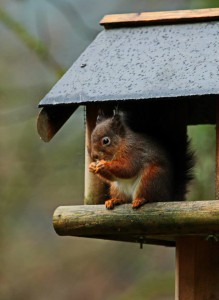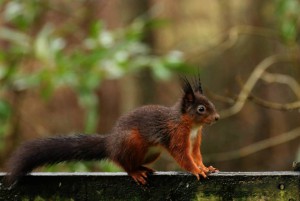Unlike some of the other wildlife in this section, you don’t have to be particularly lucky to see red squirrels which are quite common here. We often have up to seven around our bird table, competing with the many tits and chaffinches for nuts and seeds.
When I was a child in the English lake district (1970s), it was all red squirrels, but sadly the grey seems to have appeared there as well now. It is really important for woods such as those surrounding the Donich to be preserved for the red squirrel, as it is loss of habitat as well as pressure from the grey which has caused the decline of the species. Hopefully the presence of pine martens in the area will help discourage colonization from greys. This is because although martens will prey on both species, they find it much easier to catch the larger greys which spend more time at ground level.
Many red squirrels do not survive their first year for lack of food because if there is a long cold winter, their food stores can run out. Food provided by humans can be an important factor in ensuring that the maximum number of squirrels survive. If they do make it through their first year, they can live up to seven years in the wild. They are incredibly agile and adept at taking nuts – even from ‘squirrel proof’ bird feeders, and a little known fact is that they are also strong swimmers.
The squirrels in this area have a strong melanistic streak, with some of them being almost totally black.
There are many ‘drays’ or nests throughout the Donich woods, although they can be quite hard to spot. Squirrels start breeding as early as February and can have two sets of kittens in a single year.


